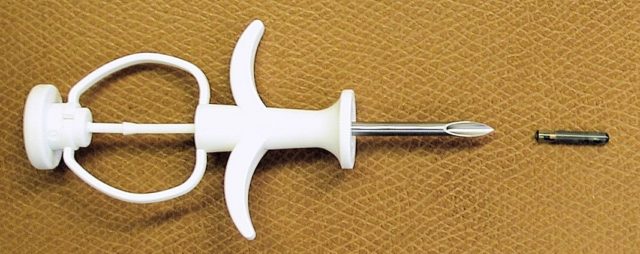There are countless stories of lost dogs reuniting with their owners thanks to their microchips. These devices are small, inexpensive, and easy to implant. If your pup came from a shelter or rescue organization, chances are he or she already has one. So why aren’t all pets required to have microchips as they are in the UK and some US cities? Is microchipping really necessary? And if so, is it safe to microchip your dog?
What are pet microchips?
The microchips implanted in pets are tiny cylindrical pods made from biocompatible glass or polymer. Each one contains an electronic chip or transponder with a unique 10 – 15 digit code. Once implanted, the chip lies dormant until passed over by a scanner. The radiowaves from the scanner activate the transponder, transmitting the identification number to the screen. The entire device is approximately the size and shape of a grain of rice.

It is a comon misconception that microchips are enabled with GPS tracking. Unfortunately, they cannot be used to locate your dog if he or she gets lost. Instead, they allow shelters, rescue organizations, and veterinary facilities to identify found pets and reunite them with their rightful owners.
Is it safe to microchip your dog?
In 1996, The British Small Animal Veterinary Association (BSAVA) started a database of adverse reactions to microchips. From 1996 to 2009, over 4 million animals were chipped and only 391 adverse reactions were reported. The most common “reaction” was migration of the microchip from its original implantation site.
Over the course of 13 years, there were:
- 36 cases of microchip failure
- 72 lost chips
- 229 cases of chip migration
- one case of hair loss at the implantation site
- 23 cases of swelling at the implantation site
- 20 cases of infection at the implantation site
- two cases of tumor formation at the implantation site
- and eight reactions listed as “unknown”
Let’s explore some of the potential reactions associated with microchipping your dog:
-Migration
The most common microchip-related problem reported to the BSAVA is microchip migration. Most microchips are implanted between the shoulder blades of dogs and cats. There are large muscle groups in this area that help keep the chip from drifting. In addition, modern microchips usually have an outer sheath to prevent migration. Still, microchips can occasionally travel to other parts of the body – most commonly the side, shoulder or elbow.
While this does not pose a health or safety risk, it does make it more difficult for the person weilding the scanner to locate the chip. However, most shelter and veterinary staff are aware of the possibility of migration. They are trained to slowly run the scanner along the neck, back and both sides of the animal before concluding a microchip is not present.
-Malfunction
Just like any device, microchips sometimes fail and cannot be detected by a scanner, but these cases are very rare. Scanners themselves can also malfunction although again, this is not common.
Microchip malfunction can often be chocked up to human error, such as improper or incomplete scanning technique. Additionally, long or matted haircoats, excessive fat deposits, metal collars or difficult behavior on the part of the dog can also interfere with scanning and detection of a microchip.

-Implantation Site Reactions
Hairloss, swelling and infections at the implantation site are all extremely rare based on the BSAVA database statistics. Each of these issues is mild and easily resolved with time and non-invasive treatment.
Although not tracked by the database, some owners report pain, discomfort or bleeding immediately after microchip implantation. The needles used to deliver the chips beneath the skin are quite large compared to those used for vaccinations or blood draws. For this reason, many veterinarians use topical anesthetics or implant microchips during routine spay/neuter surgeries to minimize these problems.
-Cancer
One of the biggest microchip safety concerns for dog owners is the risk of cancerous tumors. According to the American Veterinary Medical Association (AVMA):
“Tumors associated with microchips in two dogs and two cats have been reported, but in at least one dog and one cat the tumor could not be directly linked to the microchip itself (and may have been caused by something else).”
As for reports of cancers in microchipped mice and rats, the AVMA says the majority were being used for cancer studies when the tumors were found, and the rat and mice strains used in the studies are known to be more likely to develop cancer.

-Paralysis/Death
Tragic cases of paralysis and even death associated with microchipping have been reported in very small pets, although these cases are exceedingly rare. In one case, a Chihuahua named Charlie Brown bled to death from the tiny microchip insertion hole. Another report states that a struggling kitten passed away when its microchip entered the brain stem during implantation.
While these are isolated incidents, they certainly highlight the benefit of microchipping pets under anesthesia.
What are the alternatives to microchipping your dog?
While the benefits of microchipping your dog far outweigh the risks, whether or not to do so is still a personal choice in most of the US. According to a study of more than 7,700 shelter pets, dogs with microchips were more than twice as likely to be reunited with their owners than those without. (21.9% vs. 52.2%).
The AVMA further explains that, “for microchipped animals that weren’t returned to their owners, most of the time it was due to incorrect owner information (or no owner information) in the microchip registry database.”
However, if you are still uncertain about whether it is safe to microchip your dog, you do have other options.

-ID Tags
According to the AVMA, even if a pet has a microchip, “nothing replaces a collar with up-to-date identification tags.” However, many pets go missing without their collars or lose their ID tags while lost.
-Tattooing
Many people use tattoos for identification purposes in livestock, but the practice is far less common in domestic pets. Former racing Greyhounds may have tattoos on their ear flaps, stomachs, or inner rear legs. If you do not wish to microchip your dog, contact your vet to see if they offer tattooing.
Wide Open Pets writes:
“The genius of using tattoos as an identification method is two-fold. A tattoo can’t fall off like a tag, but doesn’t introduce a foreign object into your pet’s body like microchipping does.”
It is best to perform the procedure under anesthesia.
-GPS Devices
Several GPS tracking devices have hit the market allowing owners to pinpoint the location of their lost pet within their cellular coverage area. While many of these devices offer long battery life, shock-resistance and water-proofing, much like ID tags, they become useless if separated from the animal.
To learn more about the pros and cons of microchipping your dog, check out these posts:
Microchips Save Thousands Of Pets, But They Aren’t Always Effective
8 Things You Need To Know About Microchipping Your Dog
Canine Custody Battles Emphasize The Importance Of Microchipping Your Pets
H/T to AVMA

 Toledo, United States.
Toledo, United States.